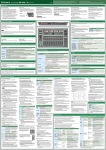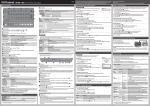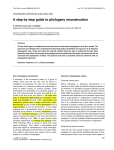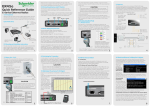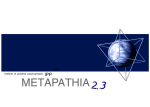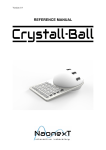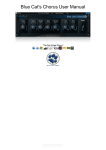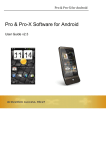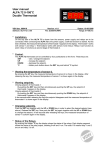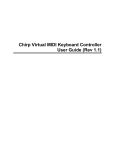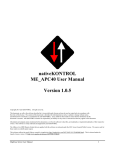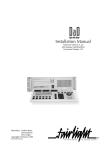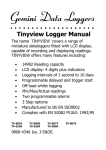Transcript
Owner’s Manual English * 5 1 0 0 0 4 4 3 3 3 - 0 1 Before using this unit, carefully read leaflet “USING THE UNIT SAFELY” . After reading, keep the document(s) including those sections where it will be available for immediate reference. Copyright © 2015 ROLAND CORPORATION All rights reserved. No part of this publication may be reproduced in any form without the written permission of ROLAND CORPORATION. * Rear Panel [POWER] switch DC IN jack USB HOST (1–4) ports USB (O) port MIDI (IN, OUT) connectors INPUT (1–4, 5/6) jacks This turns the power on/off. Connect the included AC adaptor here. ** To prevent the inadvertent disruption of power to your unit (should the plug be pulled out accidentally), and to avoid applying undue stress to the jack, anchor the power cord using the cord hook, as shown in the illustration. Use a commercially available USB 2.0 cable to connect this port to your computer. It can be used to transfer USB MIDI and USB audio data. You must install the USB driver before connecting the MX-1 to your computer. Download the USB driver from the Roland website. For details, refer to Readme. htm which is included in the download. For connecting MIDI device. ** When powering-on your equipment, you must turn on each device in the following order: devices connected to the input jacks&the MX-1&devices connected to the output jacks. Failure to observe this order could cause malfunctions or damage your equipment. When powering-off your equipment, you must turn off each device in the following order: devices connected to the output jacks&the MX-1&devices connected to the input jacks. These are dedicated USB audio input ports for use only with AIRA products (such as the TR-8, TB-3, VT-3, and SYSTEM-1). By using commercially available USB 2.0 cables to connect your AIRA products, you can input their audio output (stereo) to the MX-1 and mix the audio outputs. The USB HOST 3 port can supply USB bus power. The TB-3 or VT-3, which support bus power, can be connected here. Connect external sound sources to these jacks. By switching their settings, you can use INPUT 1–4 jacks either as monaural inputs (1, 2, 3, 4) or as stereo inputs (1/2, 3/4). INPUT 5/6 jacks support stereo input. Cord hook ** Before turning the unit on/off, always be sure to turn the volume down. Even with the volume turned down, you might hear some sound when switching the unit on/off. However, this is normal and does not indicate a malfunction. ** Do not connect any USB device other than an AIRA product. The cord of the supplied AC adaptor ** This unit is equipped with a protection circuit. A brief interval (a few seconds) after turning the unit on is required before it will operate normally. DIGITAL IN/OUT jack A two-channel (stereo) digital input/output device can be connected here. Switch the setting of this jack between input/ output depending on the device that you connect. ** Do not use connection cables that contain a built-in resistor. MIX OUT (L/MONO, R) jacks Pro duc t S upp o r t AUX SEND (L, R) jacks http://www.roland.com/support/ These jacks output the send audio to an external effect unit. Connect your amp or monitor speaker here. These jacks output the master audio. ** The master audio is not output. ** Do not use connection cables that contain a built-in resistor. AUX RETURN (L, R) jacks PHONES jack These jacks input the return audio from an external effect unit. Connect headphones here. Pro duc t S up p or t http://www.roland.com/support/ PHONES Effect Section This adjusts the headphone output. The headphones let you listen to the master audio simultaneously with the sound of the channel selected by the [SELECT] button. Even if you lower the level of the selected channel or mute it, you can listen to its sound by turning the [MIXING] knob to the SELECT position; this lets you prepare the next song or make settings for it. The effect section contains BEAT FX which lets you modify the sound by applying an effect to each channel, and MASTER FX which applies an effect to the mixed sound of all channels. [LEVEL] knob [MIXING] knob Select the steps at which the BEAT FX and MASTER FX are applied. This adjusts the volume of the headphones. The balance adjusted by the [MIXING] knob is output without further change. This adjusts the balance between the master output and the channel whose [SELECT] button is lit. Turning the knob toward SELECT decreases the volume of the master output; turning the knob toward MASTER decreases the volume of the selected channel. Pad [1]–[16] BEAT FX For each channel, you can edit the filter, slicer, or side chain settings, and modify the sound by turning them on/off for each step. The BEAT FX effect is synchronized to the tempo of the device that’s specified as the clock master. &”Operation procedure: BEAT FX settings” NOTE Name [FILTER] button [SIDE CHAIN] button [SLICER] button When the [MIXING] knob is in the SELECT position, the sound is output at the volume before the adjustment of the MX-1’s [LEVEL] fader is applied. Before you audition the sound of the selected channel, you should turn down the [LEVEL] knob to avoid damaging your hearing with high volume. MASTER FX AUX ** You can’t specify a different MASTER FX type for each channel. This applies an effect such as delay, filter, scatter, or roll to the mixed sound of all channels. By using the combination function, you can switch the MASTER FX type at each step in synchronization with the tempo.&”Operation procedure: MASTER FX settings” ** If the tempo is too fast, the type might not switch at the intended step when using the combination function. Here you can adjust the output level of the AUX SEND jacks and the input level from the AUX RETURN jacks. [SEND] knob [RETURN] knob Adjusts the send level that is output from the AUX SEND jacks. Adjusts the return level that is input from the AUX RETURN jacks. Name [MASTER FX] knob Explanation Use this knob to edit the effect parameters. The CA indications at the left and right of the [MASTER FX] knob change their appearance depending on the knob position. C lit: LOW side [TIME] button [COMBI] button [DELAY] button [FILTER] button [SCATTER] button [FLANGER] button [BIT CRUSH] button [ROLL] button CHANNEL SETTING Here you can adjust the gain and pan of each channel, as well as settings such as BEAT FX and TONE / FILTER FX. Explanation Adjusts the input gain. The level meter indicates the input gain.Range: -20–30 dB [GAIN] button &”Operation procedure: Adjusting the input gain” Adjusts the pan (stereo position). The monaural channels (1–4) provide a pan adjustment; the stereo channels (5/6, DIGITAL, USB 1–4, PC) provide a left/right balance adjustment. [PAN] button Range: L50–C0 (Center)–R50 &”Operation procedure: Adjusting the pan” [TONE] button Switches the TONE/FILTER FX type.&”Operation procedure: TONE/FILTER FX settings” [AUX] button Adjusts the volume that is output to the AUX SEND jacks.&”Operation procedure: Setting the AUX level” Selects the steps at which BEAT FX is applied, and adjusts the depth level. [BFX] button &”Operation procedure: BEAT FX settings” Specifies how the [LEVEL] fader changes the level (fader curve). [FADER] button &”Operation procedure: Fader curve settings” Name Mixer Section Name [TONE/FILTER] knob To select one channel To select multiple channels To select all Scene memory stores the settings of the CHANNEL SETTING section, the effect section, and the mixer section as a single scene, allowing you load these settings when necessary. You can store up to 64 scenes (16 pads x 4 banks). &”Operation procedure: Storing and recalling scene memories” Recall a scene memory. Store a scene memory. A lit: HIGH side Specifies the delay time or the frequency response of the filter etc. Makes settings for the combination function. Applies a delay. Applies a filter. Applies a scatter. Applies a flanger. Applies a bit crusher (producing a distinctive noisy sound). Produces a roll (repeated playback). TEMPO Explanation Edits the TONE/FILTER FX parameter that’s selected by the [TONE] button. Selects the channel whose “CHANNEL SETTING” parameters you will edit. Here you can specify the tempo and specify the MIDI clock synchronization source (clock master). You can also adjust the amount of shuffle (rhythmic bounce) on the BEAT FX and combination function. ** Even if the channel whose [SELECT] button is lit is not being output from the master output (i.e., if the channel is muted or its level is lowered), you can turn the [MIXING] knob toward the SELECT position to audition the sound. SCENE MEMORY [STORE] button CA lit: OFF Here you can adjust settings such as level, TONE / FILTER FX, BEAT FX, and MASTER FX. [SELECT] button [RECALL] button Explanation Applies a filter. Applies a side chain. Applies a slicer. [BFX] button [MFX] button START/STOP [LEVEL] fader Starts (lit) or stops (blinking) the BEAT FX. When you start, BEAT FX applies in synchronization with the tempo at the steps you specify using the pads [1]–[16]. You can also use the combination function with MASTER FX so that the type is switched for each step in synchronization with the tempo. [MUTE] button Name [TEMPO] knob [SHUFFLE] button [FINE] button Press the [SELECT] button. Hold down the [SELECT] button and press the [SELECT] button of another channel. Hold down the CHANNEL SETTING button and press the [SELECT] button. [SYNC] button [TAP] button Explanation Specifies the tempo. The tempo value is shown in the display above the knob. Range: 40.0–300.0 Adjust the amount of shuffle (rhythmic bounce). Range: -50–0–50 Specifies the tempo below the decimal point. Selects the MIDI clock synchronization source (clock master).&”Operation procedure: Synchronization settings” To set the tempo, tap this button several times at the desired interval. ** If the clock master setting is other than “INT,” the [TEMPO], [SHUFFLE], [FINE], and [TAP] buttons are inoperable. Applies the BEAT FX to the sound of the channel. &”Operation procedure: BEAT FX settings” ** The button blinks if the BEAT FX depth level is set to 0. Adjust the depth level as necessary. Specifies whether the input sound is output without change (unlit) or the MASTER FX applied (lit). &”Operation procedure: MASTER FX settings” Adjusts the level. You can specify the fader curve by which the level changes. &”Operation procedure: Fader curve settings” Mutes the sound of the channel. Master Out Section Here you can adjust the master level and the mastering effect settings. Name Explanation [MASTER LEVEL] knob Adjusts the volume that is output from the MIX OUT jacks. Edits the MASTERING FX (mastering effect) settings. &”Operation procedure: MASTER FX settings” Indicates the master output level. If the [GAIN] button is lit, the meter indicates the input level of the selected channel. [MASTERING] button Level meter Operation procedure Connecting devices Adjusting the input gain 6. Select the BEAT FX type and variation. MASTERING FX settings Connect your equipment correctly as described below. 1. Press the [GAIN] button to make it light. The MASTERING FX applies to all of the audio input. ** To prevent malfunction and equipment failure, always turn down the volume, and turn off all the units before making any connections. Type 2. Press the [SELECT] button of the channel whose input gain you want to adjust; the button lights. The value of the current setting is shown in the display above the [VALUE] knob, and the level meter changes to show the input gain. &”Mixer Section: [SELECT] button” 77Connecting external audio sources External audio sources such as an analog synth or a DJ player can be connected to the INPUT 1–4 or 5/6 jacks, or to the DIGITAL IN jack. N OT E With the default settings, INPUT 1–4 are assigned as monaural inputs, and DIGITAL IN/OUT is assigned as digital input. If you want to input stereo sources to INPUT 1–4, or if you want to use DIGITAL IN/OUT as digital output, make the appropriate changes to the system settings. &”System Settings: Channel link” 77Connecting AIRA products AIRA products such as the TR-8 and TB-3 can be connected via a commercially available USB 2.0 cable to a USB HOST port. 77Connecting computer If you want to mix the audio playback from your computer, use a commercially available USB 2.0 cable to connect the MX-1’s USB port to your computer. You must install the USB driver before connecting the MX-1 to your computer. &”Rear Panel: USB (O) port” ** With the default settings, the audio playback from your computer is input to the PC channel in stereo. ** If no AIRA product is connected to the USB HOST ports, the audio playback from your computer can be input to USB 1–4 channels and mixed. &”System Settings: Mixer mode” 77Connecting MIDI device The MX-1 can receive MIDI Clock (F8) data to synchronize its tempo. It can also receive MIDI Start (FA) and MIDI Stop (FC) to start/stop itself. 77Connecting external effect device If you want to use an external effect device or amp via the send/return jacks, connect your equipment to the AUX SEND jacks and AUX RETURN jacks. &”Operation procedure: Setting the AUX level” Synchronization settings Here’s how to select the MIDI clock master in order to synchronize the tempo of the MX-1 and the connected devices. 1. Press the [SYNC] button to make it light. 3. Turn the [VALUE] knob to adjust the gain. Adjust the gain so that the signal does not exceed 0 dB on the level meter (the green LED at the top). Adjusting the pan 1. Press the [PAN] button to make it light. 2. Press the [SELECT] button of the channel whose pan you want to adjust; the button lights. &”Mixer Section: [SELECT] button” 3. Turn the [VALUE] knob to adjust the pan. TONE/FILTER FX settings With the default settings, TONE/FILTER FX is set to “FILTER1.” 1. Press the [TONE] button to make it light. 2. Press the [SELECT] button of the channel which you want to apply; the button lights. &”Mixer Section: [SELECT] button” 3. Turn the [VALUE] knob to select the type. Number 1 2 3 Type FILTER 1 (FL1) FILTER 2 (FL2) TONE 1 (Tn1) 4 TONE 2 (Tn2) 5 6 7 8 EQ LOW 1 (Lo1) EQ LOW 2 (Lo2) EQ HI1 (Hi1) EQ HI2 (Hi2) 9 ISOLATOR 1 (iS1) 10 Explanation Low pass and high pass filters are applied. The volume of the lowfrequency and high-frequency region is changed. The volume of the lowfrequency region is changed. The volume of the highfrequency region is changed. The low-frequency and highfrequency regions are cut. The low-frequency, MiddleISOLATOR 2 (iS2) frequency and high-frequency regions are cut. 4. Turn the [TONE/FILTER] knob of each channel to adjust the depth. ** TONE/FILTER FX is off when the [TONE/FILTER] knob is in the center position; turning the knob to left or right applies the effect of the selected type. 2. Turn the [TEMPO] knob to select the MIDI clock master. The clock master you select blinks in the display above the [TEMPO] knob. BEAT FX settings Display Explanation Avto (*) If a MIDI clock is being input from a connected device, the MX-1 synchronizes to that MIDI clock. If multiple MIDI clocks are being input, the MX-1 synchronizes to one of them in the following order of priority. By using BEAT FX you can apply an effect such as filter, side chain, or slicer to individual channels. BEAT FX can also be turned on/off for individual steps to create change in the sound. 1. USB (O) port 2. MIDI IN connector 3. USB HOST 1 port 4. USB HOST 2 port 5. USB HOST 3 port 6. USB HOST 4 port The MX-1 is the MIDI clock master. The MX-1 synchronizes to the MIDI clock of the NiDi (*) device connected to the MIDI IN connector. The MX-1 synchronizes to the MIDI clock of the USB1–4 (*) device connected to the USB HOST ports. The MX-1 synchronizes to the MIDI clock that’s specified by the DAW running on the PC (*) computer connected to the USB (O) port. Int (*) If there is no MIDI clock input, the MX-1 is the MIDI clock master. 3. Press the [SYNC] button to confirm the clock master. The display changes from blinking to lit. 4. Press the [SYNC] button to make it go dark. If “INT” is selected as the clock master, use the [TEMPO] knob and [FINE] knob or the [TAP] button to specify the tempo. If a different clock master is selected, the MX-1 synchronizes to the tempo of the connected device. 1. Press the CHANNEL SETTING [BFX] button to make it light. FILTER SIDE CHAIN SLICER Explanation Cuts a specific frequency region from the input sound. Adjusts (“ducks”) the volume of the audio input. Periodically cuts the output of the input sound. ** To select the variation, hold down the [FILTER], [SIDE CHAIN], or [SLICER] button and turn the [VALUE] knob. 7. Use pads [1]–[16] to select the steps at which BEAT FX applies. ** The BEAT FX effect applies at the timing of the pads that are lit. 8. Turn the [VALUE] knob to adjust the depth level. By holding down the CHANNEL SETTING [BFX] button and turning the [VALUE] knob you can adjust the duration (gate time) during which the BEAT FX effect is applied. MASTER FX settings 3. On each channel to which you want to apply the BEAT FX, press the [BFX] button to make it light. 4. On the channel for which you want to make BEAT FX settings, press the [SELECT] button to make it light. &”Mixer Section: [SELECT] button” 5. Hold down the CHANNEL SETTING [BFX] button and use pads [1]–[16] to specify the last step (the number of steps). ** If the sound distorts when you enable the MASTERING FX, lower the level of each channel until the sound is no longer distorted. Fader curve settings You can specify the way in which the level changes when you move the [LEVEL] fader (i.e., the fader curve). 1. Press the [MASTERING] button to make it light. The MASTERING FX is enabled. 2. Hold down the [MASTERING] button and turn the [TEMPO] knob to select the type. Auditioning the selected channel You can audition the sound of the selected channel in your headphones.&”PHONES” 1. Press the [SELECT] button of the channel whose sound you want to audition; the button lights. &”Mixer Section: [SELECT] button” 1. Press the CHANNEL SETTING [FADER] button to make it light. 2. For the channel whose fader curve you want to specify, press the [SELECT] button to make it light. By lighting the [SELECT] button of multiple channels, you can set all of the selected channels to the same fader curve setting. 3. Turn the [VALUE] knob to select the fader curve. ** Turning the knob toward SELECT, you can listen only to the sound of the selected channel. 3. Turn the [LEVEL] knob to adjust the volume of the headphones. 1. On each channel to which you want to apply the MASTER FX, press the [MFX] button to make it light. Setting the AUX level Storing and recalling scene memories 2. Select the MASTER FX type. You’ll use AUX when using an external effect device via a send/return connection. Effect Type Explanation DELAY FILTER Delay is applied. Filter is applied. “Scatter” adds a digital-feeling groove to the loop playback by exchanging individual steps within the loop playback and also by changing the playback direction or gate length. Flanger is applied. Distorts the waveform, producing a distinctive noisy sound. Plays the sound repeatedly. 1. Press the CHANNEL SETTING [AUX] button to make it light. When you store a scene memory, the current settings for the channels, effect section, and mixer section are stored in the MX-1 as a single scene. You can recall the stored settings when necessary. SCATTER FLANGER BIT CRUSH ROLL ** To select a variation, hold down the button for the corresponding type and turn the [TEMPO] knob. 3. Hold down the [TIME] button and turn the [TEMPO] knob to adjust the parameter. 4. Turn the [MASTER FX] knob to adjust the depth. ** The MASTER FX effect is OFF when the [MASTER FX] knob is in the center position (CA lit); turning the knob left or right applies the effect that’s specified for each selected variation. 77Switching the type at each step (Combination function) The combination function lets you assign a MASTER FX type to each individual step, adding change to the sound. ** You can assign one type to each step. 1. Press the [START/STOP] button. 2. Press the [COMBI] button to make it light. 3. Hold down the [COMBI] button and turn the [TEMPO] knob to select a pattern (combination of the MASTER FX). You can also edit the pattern. 77Editing the pattern 1. Press the [COMBI] button to make it light. The button of the MASTER FX type that’s used by the pattern will light. 2. While holding down the button of the MASTER FX type that you want to assign, press pads [1]–[16] to select the steps on which to apply MASTER FX. The pads to which MASTER FX applies are lit. 2. For each channel that you want to send to the AUX SEND jacks, press the [SELECT] button to make the button light. &”Mixer Section: [SELECT] button” 3. Turn the [VALUE] knob to adjust the send level. 4. Turn the [SEND] knob to adjust the output volume of the AUX SEND jacks. &”System Settings: AUX SEND rooting” 77RECALL 1. Press the [RECALL] button to make it light. 2. Use the [VALUE] knob or pads [1]–[16] to select the scene number that you want to recall. If you used pads [1]–[16] to select a scene, the scene is recalled immediately.Alternatively, you can use the [VALUE] knob to select “NAn (Manual),” which makes the MX-1 use the current settings of the [TONE/FILTER FX] knobs and [LEVEL] faders. ** Immediately after a scene is recalled, the physical positions of the [LEVEL] faders, [TONE] knobs, and [MASTER FX] knob may differ from the recalled values. ** If the recalled value differs from the physical position of a [LEVEL] fader, the periphery of the fader blinks. 3. If you used the [VALUE] knob to select a scene, press the [RECALL] button to recall the scene. Operation with a DAW 2. Turn the [MIXING] knob to adjust the volume balance between the selected channel and the master output. MASTER FX lets you apply effects such as delay, filter, and scatter. By using the combination function, you can switch the effect type at each step. 4. Turn the [MASTER FX] knob to adjust the depth. 2. Press the [START/STOP] button to start the BEAT FX. 5. Turn the [RETURN] knob to adjust the output volume of the AUX RETURN jacks. &”System Settings: AUX RETURN rooting” 77STORE 1. Press the [STORE] button to make it light. 2. Use the [VALUE] knob or pads [1]–[16] to select the scene number that you want to store. The [STORE] button blinks. 3. Press the [STORE] button to store the settings. In addition to mixing the sounds of AIRA products and other hardware, the MX-1 can work with a DAW on your computer to mix the playback of the DAW and operate as a DAW controller. To use the MX-1 with your DAW, you’ll need to change the system settings. &”System Settings: Mixer mode” Main Specifications Roland MX-1: MIX PERFORMER Power Supply AC adaptor Current Draw 1700mA 400 (W) x 264 (D) x 65 (H) mm Dimensions 15-3/4 (W) x 10-7/16 (D) x 2-9/16 (H) inches 1.81 kg Weight 4 lbs AC adaptor, Owner’s manual, Leaflet “USING THE Accessories UNIT SAFELY“, Ableton Live Lite Serial Number Card ** In the interest of product improvement, the specifications and/or appearance of this unit are subject to change without prior notice. Various Settings Restoring the Factory Settings (Factory Reset) 1. While holding down the [RECALL] button, turn on the power. The display indicates “rSt” and the [START/STOP] button blinks. Settings Operation AUX RETURN Press the Pad [3] rooting 2. Press the [START/STOP] button to execute the factory reset. 3. When the display indicates “CNP,” turn the MX-1’s power off, then on again. MIDI through Press the Pad [4] Value/ State Explanation Unlit (Off ) * Specifies whether MASTER FX is applied to the input from the AUX RETURN jacks (lit) or is not applied (unlit). Lit (On) Unlit (Off ) * Lit (On) System Settings NiX (MIXER mode) * Here’s how to change the MX-1’s system settings. 1. While holding down the [GAIN] button, turn on the power. 2. Use the buttons, knobs and the pads to change the settings. The default values or states are marked with “*.” Settings Channel link DIGITAL jack setting USB audio frequency Operation Value/ State Press the channel 1 Channel 2 lit * or 2 [SELECT] button Channel 2 unlit Press the channel 3 Channel 4 lit * or 4 [SELECT] button Channel 4 unlit * Press the DIGITAL Unlit channel [SELECT] Lit * button. Press the [BFX] button and turn the 44.1, 48, 96 [VALUE] knob Press the [SHUFFLE] OFF, C1–C16 MIDI channel button and turn the [TEMPO] knob ONni(Omni) ** When you edit the settings, the pattern is overwritten automatically. Unlit (Jump) * LEVEL fader mode Press the Pad [1] Lit (Pass through) ** The steps loop at the pad that you specify as the last step. AUX SEND rooting Unlit * Press the Pad [2] Lit Explanation Supports monaural input. Supports stereo input. Supports monaural input. Supports stereo input. The jack operates as an output jack. Mixer mode SvR (CONTROL SURFACE ** Press the [TONE] mode) button and turn the [VALUE] knob The sound of hardware connected to the MX-1 is not mixed; the sound adjusted by the [GAIN] button is sent to the computer. The sound of the PC channel is sent from the MIX OUT jacks. The MX-1 operates with the DAW on your computer to mix the playback of multiple tracks. EXT (EXTERNAL MIXING mode) The jack operates as an input jack. Specifies the sampling rate (kHz). (Default: 96) Specifies the MIDI transmit/receive channel. The display indicates the channel. (Default: 15) MIDI messages of all channels are received. The MIDI transmit channel will be 15. If you’ve recalled a scene memory and the physical position of a fader differs from the value that was recalled, operating that fader causes the value to jump immediately to the fader position. If you’ve recalled a scene memory and the physical position of a fader differs from the value that was recalled, fader movement is ignored until the fader passes through the recalled value. Output the sound before it is adjusted by the [LEVEL] fader (pre-fader send). Output the sound after it is adjusted by the [LEVEL] fader (post-fader send). LED demo Pad coloration System Version Specifies whether data received from the MIDI IN connector will be retransmitted from the MIDI OUT connector (On) or will not be retransmitted (Off ). Mixes the AIRA products or other hardware that is connected to the MX-1. If no AIRA products are connected to the USB HOST ports, the playback from the computer is input to USB channels 1–4 and can be mixed. MIDI channels (1–11) are assigned starting at channel 1 of the MX-1, allowing the MX-1 to operate as a USB controller for your DAW. Press the [PAN] button and turn the OFF, 1–30 [VALUE] knob Press the [AUX] button and turn the CL1–6 [VALUE] knob Press the [GAIN] --button ** The gain of the DAW playback cannot be adjusted by the MX-1. Adjust the output levels in your DAW. ** The sound of hardware connected to the MX-1 is not mixed; the sound adjusted by the [GAIN] button is sent to the computer. Specifies the time (minutes) until the LED demo is shown. (Default: 5 min) Specifies the pad color scheme for each function. (Default: CL 1) Displays the MX-1’s software version. 3. Press the [START/STOP] button to save the settings. The settings are saved, and the MX-1 restarts.
